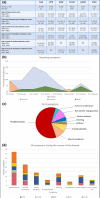Long-term prognosis of fatty-acid oxidation disorders in adults: Optimism despite the limited effective therapies available
- PMID: 38015438
- PMCID: PMC11235989
- DOI: 10.1111/ene.16138
Long-term prognosis of fatty-acid oxidation disorders in adults: Optimism despite the limited effective therapies available
Abstract
Introduction: Fatty-acid oxidation disorders (FAODs) are recessive genetic diseases.
Materials and methods: We report here clinical and paraclinical data from a retrospective study of 44 adults with muscular FAODs from six French reference centers for neuromuscular or metabolic diseases.
Results: The study cohort consisted of 44 adult patients: 14 with carnitine palmitoyl transferase 2 deficiency (32%), nine with multiple acyl-CoA deficiency (20%), 13 with very long-chain acyl-CoA dehydrogenase deficiency (30%), three with long-chain 3-hydroxyacyl-CoA dehydrogenase deficiency (7%), and five with short-chain acyl-CoA dehydrogenase deficiency (11%). Disease onset occurred during childhood in the majority of patients (59%), with a mean age at onset of 15 years (range = 0.5-35) and a mean of 12.6 years (range = 0-58) from disease onset to diagnosis. The principal symptoms were acute muscle manifestations (rhabdomyolysis, exercise intolerance, myalgia), sometimes associated with permanent muscle weakness. Episodes of rhabdomyolysis were frequent (84%), with a mean creatinine kinase level of 68,958 U/L (range = 660-300,000). General metabolic complications were observed in 58% of patients, respiratory manifestations in 18% of cases, and cardiological manifestations in 9% of cases. Fasting acylcarnitine profile was used to orient genetic explorations in 65% of cases. After a mean follow-up of 10 years, 33% of patients were asymptomatic and 56% continued to display symptoms after exercise. The frequency of rhabdomyolysis decreased after diagnosis in 64% of cases.
Conclusion: A standardized register would complete this cohort description of muscular forms of FAODs with exhaustive data, making it possible to assess the efficacy of therapeutic protocols in real-life conditions and during the long-term follow-up of patients.
Keywords: acylcarnitine profile; beta-oxidation; exercise intolerance; fatty acids; genetic analyses; long-term improvement; muscle weakness; rhabdomyolysis.
© 2023 The Authors. European Journal of Neurology published by John Wiley & Sons Ltd on behalf of European Academy of Neurology.
Figures





References
-
- de Lonlay P, Djouadi F, Bonnefont JP, Saudubray JM, Bastin J. [Mitochondrial beta‐oxidation of fatty acids: an essential metabolic pathway of muscular function]. Arch Pediatr. 2002;9(Suppl 2):175s‐178s. - PubMed
-
- Vargas CR, Ribas GS, da Silva JM, et al. Selective screening of fatty acids oxidation defects and organic acidemias by liquid chromatography/tandem mass spectrometry acylcarnitine analysis in Brazilian patients. Arch Med Res. 2018;49(3):205‐212. - PubMed
-
- Landau YE, Waisbren SE, Chan LMA, Levy HL. Long‐term outcome of expanded newborn screening at Boston children's hospital: benefits and challenges in defining true disease. J Inherit Metab Dis. 2017;40(2):209‐218. - PubMed
-
- Janeiro P, Jotta R, Ramos R, et al. Follow‐up of fatty acid β‐oxidation disorders in expanded newborn screening era. Eur J Pediatr. 2019;178(3):387‐394. - PubMed
-
- Laforêt P, Vianey‐Saban C, Vissing J. 162nd ENMC International Workshop: disorders of muscle lipid metabolism in adults 28‐30 November 2008, Bussum, The Netherlands. Neuromuscul Disord. 2010;20(4):283‐289. - PubMed
MeSH terms
LinkOut - more resources
Full Text Sources
Medical

